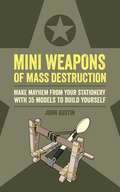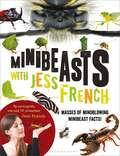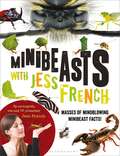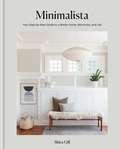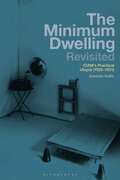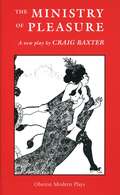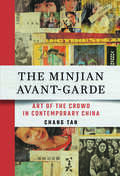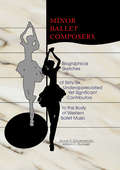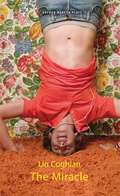- Table View
- List View
Mini Patchwork Projects: 6 Sewing Patterns for the Contemporary Crafter
by Beth Studley6 quick and simple stash-busting mini projects for quilters and sewers. Projects range from mini baskets for threads and spools, picture bunting for inspiration and a notebook cover for design ideas. Unique designs for sewing patterns by Beth Studley (Love From Beth) who is a fabric designer and sewing and quilt pattern designer.
Mini Weapons of Mass Destruction: Make mayhem from your stationery with 35 models to build yourself (Mini Weapons of Mass Destruction)
by John AustinWe've come a long way from the Peashooter Era: with the advent of modern household products and office supplies - foldback clips, clothespins, rubber bands, ballpoint pens, toothpicks, paper clips and plastic utensils - the everyday junk drawer can hold all the materials needed to create pocket-sized weaponry. Whether you're slowing dying of boredom in a stuffy office, plotting revenge on your older siblings or simply looking for a wonderful way to kill some time, this book is for you. Toy designer John Austin provides detailed, step-by-step instructions for each project, including materials and ammo lists, clear pictures, and construction tips, for mayhem-loving MacGyvers. The 35 devices include catapults, slingshots, darts, crossbows, and combustion shooters. Build a tiny trebuchet from paper clips and a D-cell battery. Wrap a penny in a string of paper caps to create a surprisingly impressive "bomb." Several of the projects even include variations where combatants mount laser pointer sights to their shooters to increase their accuracy. The instructions are simple so that anyone can make these wacky innovations in minutes whilst also learning about mechanics and physics in a fun, hands-on way.
Miniature Railways (Shire Library)
by David HenshawThere are more than 400 miniature railways in Britain. Some are hidden away and privately owned, others are parkland attractions, and some – such as the Romney, Hythe and Dymchurch – are large commercial enterprises. They come in an array of gauges (from 5 inches up to 15 inches and sometimes beyond), but their most definitive characteristic is that they can carry passengers, whether sitting astride the rolling stock or inside enclosed carriages. In this colourfully illustrated guide, David Henshaw offers a concise history of miniature railways from the nineteenth century to the modern day, including a whistle-stop tour of the most notable examples open to the public – including the Ravenglass & Eskdale, Bure Valley and Eastleigh Lakeside railways – exploring their layouts, engineering and rolling stock.
Miniature Railways (Shire Library)
by David HenshawThere are more than 400 miniature railways in Britain. Some are hidden away and privately owned, others are parkland attractions, and some – such as the Romney, Hythe and Dymchurch – are large commercial enterprises. They come in an array of gauges (from 5 inches up to 15 inches and sometimes beyond), but their most definitive characteristic is that they can carry passengers, whether sitting astride the rolling stock or inside enclosed carriages. In this colourfully illustrated guide, David Henshaw offers a concise history of miniature railways from the nineteenth century to the modern day, including a whistle-stop tour of the most notable examples open to the public – including the Ravenglass & Eskdale, Bure Valley and Eastleigh Lakeside railways – exploring their layouts, engineering and rolling stock.
Minibeasts with Jess French: Masses of mindblowing minibeast facts!
by Jess FrenchFancy meeting a foot-long centipede or a spider the size of your dinner plate? Willing to let the world's weirdest and most fascinating minibeasts join you on your sofa?Then allow Jess French to lead you head first through the unbelievable world of invertebrates and explore their incredible adaptations, from dancing scorpions and blood-sucking moths to zombie spiders and slime-shooting worms.Marvel at how minibeasts have evolved to survive in almost every describable habitat. Discover the fascinating ways they find food, mate, fight, hide and collaborate in even the most extreme conditions! And pore over more than 250 breathtakingly detailed photographs of astonishing invertebrates.With her unparalled zeal for minibeasts, Jess will enlighten you on the most fascinating and intense aspects of the minibeast world, revealing everything from cloaks made of corpses to mid-flight kamikaze mating.
Minibeasts with Jess French: Masses of mindblowing minibeast facts!
by Jess FrenchFancy meeting a foot-long centipede or a spider the size of your dinner plate? Willing to let the world's weirdest and most fascinating minibeasts join you on your sofa?Then allow Jess French to lead you head first through the unbelievable world of invertebrates and explore their incredible adaptations, from dancing scorpions and blood-sucking moths to zombie spiders and slime-shooting worms.Marvel at how minibeasts have evolved to survive in almost every describable habitat. Discover the fascinating ways they find food, mate, fight, hide and collaborate in even the most extreme conditions! And pore over more than 250 breathtakingly detailed photographs of astonishing invertebrates.With her unparalled zeal for minibeasts, Jess will enlighten you on the most fascinating and intense aspects of the minibeast world, revealing everything from cloaks made of corpses to mid-flight kamikaze mating.
Minimalista: Your step-by-step guide to a better home, wardrobe and life
by Shira Gill***"I identified with so many of the important lessons Shira teaches in Minimalista. Now I'll know what book to recommend when people ask me to help them on their journey towards minimalism!" - Garance Doré, New York Times Best Selling Author of Love Style LifeElevate your personal style, trim your belongings, and transform your life, one room at a time, with this visionary lifestyle and home organisation book from organising expert, Shira Gill.As a professional home organiser with clients ranging from students to multi-millionaires, Shira Gill observed that clutter is a universal stress trigger. Over the years she created a signature decluttering and organisation process that promotes sustainability, achieves lasting results, and can be applied to anyone, regardless of their space or lifestyle. Rather than imposing strict rules and limitations, Shira redefines minimalism as having the perfect amount of everything - for you - based on your personal values and the limitations of your space. Now, in Minimalista, Shira shares her complete toolkit for the first time, built around five key steps: Clarify, Edit, Organize, Elevate, and Maintain. Shira teaches that the most important thing you can do is start, and that small victories, achieved one at a time, will snowball into massive transformation. Broken into small, bite-sized chunks, Minimalista makes it clear that if the process is fun and easy to follow, anyone can learn the principles of editing and organisation.The Minimalista Manifesto· Buy less; live more.· Invest in high quality + solid craftsmanship.· Opt for natural, sustainable materials.· Treat your space + your stuff with respect.· Shop your own home before hitting the stores.· Celebrate life's little luxuries: fresh flowers, hot water, a good meal with friends.· Try to repair instead of replace.· Embrace negative space and dispose of unwanted items responsibly.· Create a home that supports your personal goals + core values.· Be the gatekeeper of your home.· Say "no" to swag, freebies, and hotel samples.· Say "no" to excess and "yes" to enough.
The Minimum Dwelling Revisited: CIAM's Practical Utopia (1928–31)
by Professor Aristotle KallisThis book provides an intellectual history of the modernist "minimum dwelling", exploring how early modernism saw mass housing as a primary vehicle for achieving the utopian transformation of society. It reappraises the often-overlooked 2nd and 3rd CIAM conferences (1929-31), addressing their engagement with the "minimum dwelling" and revealing them both as milestones in the organisation's annals and as seminal moments in the history of interwar modernism.In 1929, an eclectic international group of avant-garde modernist architects, including Ernst May, Mart Stam, Walter Gropius and Le Corbusier, met in Frankfurt for the second instalment of the CIAM conferences. They discussed a design programme for cost-effective, good-quality housing, seeking new approaches and processes to maximize quality and functionality while ensuring affordability for the wider population. In exploring the meaning and form of the 'minimum dwelling', they also re-defined dwelling as the hub of a new way of living, proposing a revolutionary multi-scalar approach to urban design based on the concept of the Existenzminimum ('optimally minimal housing').Despite the two conferences falling short of the organizer's expectations, and being overshadowed by later instalments, the participating architects sanctioned a semantic shift from minimum as bare necessity to a very different, aspirational, kind of minimalism – transforming the entire conversation on mass low-cost dwelling in design, social and ethical terms.Split into two parts, The Minimum Dwelling Revisited first takes a genealogical approach to explore the provenance of the concept of "minimum dwelling" prior to the 2nd and 3rd CIAM conferences, it then traces the proceedings of the two conferences themselves. Addressing the origins of the "minimum dwelling" concept but also its legacies, and serving as a corrective to the overemphasis on 4th CIAM conference and the Athens Charter, the book is essential reading for scholars researching urban design during the Interwar period.
The Minimum Dwelling Revisited: CIAM's Practical Utopia (1928–31)
by Professor Aristotle KallisThis book provides an intellectual history of the modernist "minimum dwelling", exploring how early modernism saw mass housing as a primary vehicle for achieving the utopian transformation of society. It reappraises the often-overlooked 2nd and 3rd CIAM conferences (1929-31), addressing their engagement with the "minimum dwelling" and revealing them both as milestones in the organisation's annals and as seminal moments in the history of interwar modernism.In 1929, an eclectic international group of avant-garde modernist architects, including Ernst May, Mart Stam, Walter Gropius and Le Corbusier, met in Frankfurt for the second instalment of the CIAM conferences. They discussed a design programme for cost-effective, good-quality housing, seeking new approaches and processes to maximize quality and functionality while ensuring affordability for the wider population. In exploring the meaning and form of the 'minimum dwelling', they also re-defined dwelling as the hub of a new way of living, proposing a revolutionary multi-scalar approach to urban design based on the concept of the Existenzminimum ('optimally minimal housing').Despite the two conferences falling short of the organizer's expectations, and being overshadowed by later instalments, the participating architects sanctioned a semantic shift from minimum as bare necessity to a very different, aspirational, kind of minimalism – transforming the entire conversation on mass low-cost dwelling in design, social and ethical terms.Split into two parts, The Minimum Dwelling Revisited first takes a genealogical approach to explore the provenance of the concept of "minimum dwelling" prior to the 2nd and 3rd CIAM conferences, it then traces the proceedings of the two conferences themselves. Addressing the origins of the "minimum dwelling" concept but also its legacies, and serving as a corrective to the overemphasis on 4th CIAM conference and the Athens Charter, the book is essential reading for scholars researching urban design during the Interwar period.
Mining Data for Financial Applications: 4th ECML PKDD Workshop, MIDAS 2019, Würzburg, Germany, September 16, 2019, Revised Selected Papers (Lecture Notes in Computer Science #11985)
by Valerio Bitetta Ilaria Bordino Andrea Ferretti Francesco Gullo Stefano Pascolutti Giovanni PontiThis book constitutes revised selected papers from the 4th Workshop on Mining Data for Financial Applications, MIDAS 2019, held in conjunction with ECML PKDD 2019, in Würzburg, Germany, in September 2019. The 8 full and 3 short papers presented in this volume were carefully reviewed and selected from 16 submissions. They deal with challenges, potentialities, and applications of leveraging data-mining tasks regarding problems in the financial domain.
Mining Intelligence and Knowledge Exploration: 9th International Conference, MIKE 2021, Hammamet, Tunisia, November 1–3, 2021, Proceedings (Lecture Notes in Computer Science #13119)
by Richard Chbeir Yannis Manolopoulos Rajendra PrasathThis book constitutes revised selected papers from the refereed proceedings of the 9th International Conference on Mining Intelligence and Knowledge Exploration, MIKE 2021, which took place in Hammamet, Tunisia, in November 2021. The 22 full papers included in this book were carefully reviewed and selected from 61 submissions. They deal with topics such as evolutionary computation, knowledge exploration in IoT, artificial intelligence, machine learning, data mining and information retrieval, medical image analysis, pattern recognition and computer vision, speech / signal processing, text mining and natural language processing, intelligent security systems, Smart and Intelligent Systems, etc.
Mining Intelligence and Knowledge Exploration: 9th International Conference, MIKE 2023, Kristiansand, Norway, June 28–30, 2023, Proceedings (Lecture Notes in Computer Science #13924)
by Seifedine Kadry Rajendra PrasathThis book constitutes the refereed post-conference proceedings of the 9th International Conference on Mining Intelligence and Knowledge Exploration, MIKE 2023, held in Kristiansand, Norway, during June 28–30, 2023. The 22 full papers and 16 short papers included in this book were carefully reviewed and selected from 87 submissions. They were grouped into various subtopics including Knowledge Exploration in IoT, Medical Informatics, Machine Learning, Text Mining, Natural Language Processing, Cryptocurrency and Blockchain, Application of Artificial Intelligence, and other areas.
The Ministry of Education Film Experiment: From Post-War Visual Education to 21st Century Literacy
by Alex SouthernThis book uncovers a unique post-war film production programme and explores how this first British government intervention into ‘visual education’ is relevant to film education today. In 1943 the Ministry of Education took the decision to sponsor production of an experimental programme of nonfiction films specifically for the classroom. Almost 70 years later, the British Film Institute launched a new strategic development plan, at the centre of which was the aim to prove the value of ‘21st century literacy’ to Government and embed film in the school curriculum. This aim had been the focus of film education initiatives in previous decades, without resolution. Through archival research into original documents and the films, The Ministry of Education Film Experiment builds a story of conflict and collaboration between the Ministry and the filmmakers, offering an insight into why the struggle for government recognition of film education still remains.
Ministry of Illusion: Nazi Cinema and Its Afterlife
by Eric RentschlerGerman cinema of the Third Reich, even a half-century after Hitler's demise, still provokes extreme reactions. "Never before and in no other country," observes director Wim Wenders, "have images and language been abused so unscrupulously as here, never before and nowhere else have they been debased so deeply as vehicles to transmit lies." More than a thousand German feature films that premiered during the reign of National Socialism survive as mementoes of what many regard as film history's darkest hour. As Eric Rentschler argues, however, cinema in the Third Reich emanated from a Ministry of Illusion and not from a Ministry of Fear. Party vehicles such as Hitler Youth Quex and anti-Semitic hate films such as Jew Süss may warrant the epithet "Nazi propaganda," but they amount to a mere fraction of the productions from this era. The vast majority of the epoch's films seemed to be "unpolitical"--melodramas, biopix, and frothy entertainments set in cozy urbane surroundings, places where one rarely sees a swastika or hears a "Sieg Heil." Minister of propaganda Joseph Goebbels, Rentschler shows, endeavored to maximize film's seductive potential, to cloak party priorities in alluring cinematic shapes. Hitler and Goebbels were master showmen enamored of their media images, the Third Reich was a grand production, the Second World War a continuing movie of the week. The Nazis were movie mad, and the Third Reich was movie made. Rentschler's analysis of the sophisticated media culture of this period demonstrates in an unprecedented way the potent and destructive powers of fascination and fantasy. Nazi feature films--both as entities that unreeled in moviehouses during the regime and as productions that continue to enjoy wide attention today--show that entertainment is often much more than innocent pleasure.
The Ministry of Pleasure (Oberon Modern Plays)
by Craig BaxterAmid the splendours and pretensions of the royal court, the Earl of Rochester impresses Charles II with his irreverence and plain speech. So much so, that the monarch gives him the task of creating a ‘ministry of pleasure', thus liberating him to tour the country in search of all manner of delights.Featuring some of Rochester's most infamous poems, The Ministry of Pleasure opened at the Latchmere Theatre, London in June 2004.
The Minjian Avant-Garde: Art of the Crowd in Contemporary China
by Chang TanThe Minjian Avant-Garde studies how experimental artists in China mixed with, brought changes to, and let themselves be transformed by minjian, the volatile and diverse public of the post-Mao era. Departing from the usual emphasis on art institutions, global markets, or artists' communities, Chang Tan proposes a new analytical framework in the theories of socially engaged art that stresses the critical agency of participants, the affective functions of objects, and the versatility of the artists in diverse sociopolitical spheres.Drawing from hitherto untapped archival materials and interviews with the artists, Tan challenges the views of Chinese artists as either dissidents or conformists to the regime and sees them as navigators and negotiators among diverse political discourses and interests. She questions the fetishization of marginalized communities among practitioners of progressive art and politics, arguing that the members of minjian are often more complex, defiant, and savvy than the elites would assume. The Minjian Avant-Garde critically assesses the rise of populism in both art and politics and show that minjian could constitute either a democratizing or a coercive force.This book was published with generous support from the George Dewey and Mary J. Krumrine Endowment.
Minor Ballet Composers: Biographical Sketches of Sixty-Six Underappreciated Yet Significant Contributors to the Body of West
by William E Studwell Bruce R SchuenemanWhile most music lovers are familiar with the famous scores of Tchaikovsky, Delibes, and Stravinsky, many other lesser-known composers also wrote for the ballet. Several of these composers wrote almost exclusively for the ballet--and all enriched the world of dance. Minor Ballet Composers presents biographical sketches of 66 underappreciated ballet composers of the 19th and 20th centuries from around the world, along with selected stories from the ballets they helped create. While the composers’contributions to ballet music are emphasized, all aspects of their lives and works are touched upon. Plot summaries and excerpts from reviews of many of the ballets are also provided. Other topics of interest you’ll find covered in Minor Ballet Composers include: Les Six: Darius Milhaud, Louis Durey, Georges Auric, Arthur Honegger, Francis Poulenc, and Germaine Tailleferre--and their relationship with Erik Satie and Jean Cocteau how politics, revolutions, and wars have affected composers and their works who studied with whom; who collaborated with whom schools, movements, and musical renaissance the importance of opera to ballet music the relationship between film scores and ballet music which books, plays, stories, and folk tales certain ballets are based upon where many of these ballets premieredMinor Ballet Composers emphasizes the importance of second-tier composers and their influence on the rich tradition of music written for the dance (though in some cases the music was appropriated for the ballet from other original designs). The gathering of these composers in a single volume in appreciation of their ballet music, with a glossary of choreographers and an index of ballet titles, makes this book a useful volume for ballet aficionados, music librarians, musicians, and others interested in dance and dance music.
Minor Ballet Composers: Biographical Sketches of Sixty-Six Underappreciated Yet Significant Contributors to the Body of West
by William E Studwell Bruce R SchuenemanWhile most music lovers are familiar with the famous scores of Tchaikovsky, Delibes, and Stravinsky, many other lesser-known composers also wrote for the ballet. Several of these composers wrote almost exclusively for the ballet--and all enriched the world of dance. Minor Ballet Composers presents biographical sketches of 66 underappreciated ballet composers of the 19th and 20th centuries from around the world, along with selected stories from the ballets they helped create. While the composers’contributions to ballet music are emphasized, all aspects of their lives and works are touched upon. Plot summaries and excerpts from reviews of many of the ballets are also provided. Other topics of interest you’ll find covered in Minor Ballet Composers include: Les Six: Darius Milhaud, Louis Durey, Georges Auric, Arthur Honegger, Francis Poulenc, and Germaine Tailleferre--and their relationship with Erik Satie and Jean Cocteau how politics, revolutions, and wars have affected composers and their works who studied with whom; who collaborated with whom schools, movements, and musical renaissance the importance of opera to ballet music the relationship between film scores and ballet music which books, plays, stories, and folk tales certain ballets are based upon where many of these ballets premieredMinor Ballet Composers emphasizes the importance of second-tier composers and their influence on the rich tradition of music written for the dance (though in some cases the music was appropriated for the ballet from other original designs). The gathering of these composers in a single volume in appreciation of their ballet music, with a glossary of choreographers and an index of ballet titles, makes this book a useful volume for ballet aficionados, music librarians, musicians, and others interested in dance and dance music.
Minority Politics at the Millennium (Contemporary Urban Affairs)
by Richard A. Keiser Katherine UnderwoodFirst published in 2000. Routledge is an imprint of Taylor & Francis, an informa company.
Minority Politics at the Millennium (Contemporary Urban Affairs)
by Richard A. Keiser Katherine UnderwoodFirst published in 2000. Routledge is an imprint of Taylor & Francis, an informa company.
Minoru Yamasaki: Humanist Architecture for a Modernist World
by Dale Allen GyureThe first book to reevaluate the evocative and polarizing work of one of midcentury America’s most significant architects Born to Japanese immigrant parents in Seattle, Minoru Yamasaki (1912–1986) became one of the towering figures of midcentury architecture, even appearing on the cover of Time magazine in 1963. His self-proclaimed humanist designs merged the modern materials and functional considerations of postwar American architecture with traditional elements such as arches and colonnades. Yamasaki’s celebrated and iconic projects of the 1950s and ’60s, including the Lambert–St. Louis Airport and the U.S. Science Pavilion in Seattle, garnered popular acclaim. Despite this initial success, Yamasaki’s reputation began to decline in the 1970s with the mixed critical reception of the World Trade Center in New York, one of the most publicized projects in the world at the time, and the spectacular failure of St. Louis’s Pruitt-Igoe Apartments, which came to symbolize the flaws of midcentury urban renewal policy. And as architecture moved in a more critical direction influenced by postmodern theory, Yamasaki seemed increasingly old-fashioned. In the first book to examine Yamasaki’s life and career, Dale Allen Gyure draws on a wealth of previously unpublished archival material, and nearly 200 images, to contextualize his work against the framework of midcentury modernism and explore his initial successes, his personal struggles—including with racism—and the tension his work ultimately found in the divide between popular and critical taste.
Minoru Yamasaki and the Fragility of Architecture
by Paul KidderFew figures in the American arts have stories richer in irony than does architect Minoru Yamasaki. While his twin towers of New York’s World Trade Center are internationally iconic, few who know the icon recognize its architect’s name or know much about his portfolio of more than 200 buildings. One is tempted to call him America’s most famous forgotten architect. He was classed in the top tier of his profession in the 1950s and ’60s, as he carried modernism in novel directions, yet today he is best known not for buildings that stand but for two projects that were destroyed under tragic circumstances: the twin towers and the Pruitt-Igoe housing project in St. Louis. This book undertakes a reinterpretation of Yamasaki’s significance that combines architectural history with the study of his intersection with defining moments of American history and culture. The story of the loss and vulnerability of Yamasaki’s legacy illustrates the fragility of all architecture in the face of natural and historical forces, yet in Yamasaki’s view, fragility is also a positive quality in architecture: the source of its refinement, beauty, and humanity. We learn something essential about architecture when we explore this tension of strength and fragility. In the course of interpreting Yamasaki’s architecture through the wide lens of the book we see the mid-century role of Detroit as an industrial power and architectural mecca; we follow a debate over public housing that entailed the creation and eventual destruction of many thousands of units; we examine competing attempts to embody democratic ideals in architecture and to represent those ideals in foreign lands; we ponder the consequences of anti-Japanese prejudice and the masculism of the architectural profession; we see Yamasaki’s style criticized for its arid minimalism yet equally for its delicacy and charm; we observe Yamasaki making a great name for himself in the Arab world but his twin towers ultimately destroyed by Islamic militants. As this curious tale of ironies unfolds, it invites reflection on the core of modern architecture’s search for meaning and on the creative possibilities its legacy continues to offer. Beautifully illustrated with over 100 color illustrations of Yamasaki’s buildings, this book will be of interest to students, academics and professionals in a range of disciplines, including architectural history, architectural theory, architectural preservation, and urban design and planning.
Minoru Yamasaki and the Fragility of Architecture
by Paul KidderFew figures in the American arts have stories richer in irony than does architect Minoru Yamasaki. While his twin towers of New York’s World Trade Center are internationally iconic, few who know the icon recognize its architect’s name or know much about his portfolio of more than 200 buildings. One is tempted to call him America’s most famous forgotten architect. He was classed in the top tier of his profession in the 1950s and ’60s, as he carried modernism in novel directions, yet today he is best known not for buildings that stand but for two projects that were destroyed under tragic circumstances: the twin towers and the Pruitt-Igoe housing project in St. Louis. This book undertakes a reinterpretation of Yamasaki’s significance that combines architectural history with the study of his intersection with defining moments of American history and culture. The story of the loss and vulnerability of Yamasaki’s legacy illustrates the fragility of all architecture in the face of natural and historical forces, yet in Yamasaki’s view, fragility is also a positive quality in architecture: the source of its refinement, beauty, and humanity. We learn something essential about architecture when we explore this tension of strength and fragility. In the course of interpreting Yamasaki’s architecture through the wide lens of the book we see the mid-century role of Detroit as an industrial power and architectural mecca; we follow a debate over public housing that entailed the creation and eventual destruction of many thousands of units; we examine competing attempts to embody democratic ideals in architecture and to represent those ideals in foreign lands; we ponder the consequences of anti-Japanese prejudice and the masculism of the architectural profession; we see Yamasaki’s style criticized for its arid minimalism yet equally for its delicacy and charm; we observe Yamasaki making a great name for himself in the Arab world but his twin towers ultimately destroyed by Islamic militants. As this curious tale of ironies unfolds, it invites reflection on the core of modern architecture’s search for meaning and on the creative possibilities its legacy continues to offer. Beautifully illustrated with over 100 color illustrations of Yamasaki’s buildings, this book will be of interest to students, academics and professionals in a range of disciplines, including architectural history, architectural theory, architectural preservation, and urban design and planning.
The Miracle (Oberon Modern Plays)
by Lin CoghlanWhen the canal burst its banks and a holy statue arrived through her bedroom floor, no one was more surprised than 12-year-old Veronica. With the help of her best friend she sets about using her new-found skills to create something magical within her ailing community.A contemporary play for younger people, The Miracle opened at the National Theatre in February 2008
The Miracle of Analogy: or The History of Photography, Part 1
by Kaja SilvermanThe Miracle of Analogy is the first of a two-volume reconceptualization of photography. It argues that photography originates in what is seen, rather than in the human eye or the camera lens, and that it is the world's primary way of revealing itself to us. Neither an index, representation, nor copy, as conventional studies would have it, the photographic image is an analogy. This principle obtains at every level of its being: a photograph analogizes its referent, the negative from which it is generated, every other print that is struck from that negative, and all of its digital "offspring." Photography is also unstoppably developmental, both at the level of the individual image and of medium. The photograph moves through time, in search of other "kin," some of which may be visual, but others of which may be literary, architectural, philosophical, or literary. Finally, photography develops with us, and in response to us. It assumes historically legible forms, but when we divest them of their saving power, as we always seem to do, it goes elsewhere. The present volume focuses on the nineteenth century and some of its contemporary progeny. It begins with the camera obscura, which morphed into chemical photography and lives on in digital form, and ends with Walter Benjamin. Key figures discussed along the way include Nicéphore Niépce, Louis Daguerre, William Fox-Talbot, Jeff Wall, and Joan Fontcuberta.

